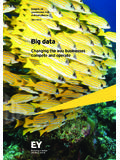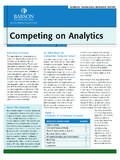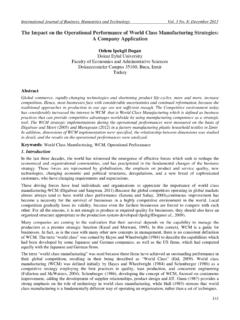Transcription of Using Market Segmentation for Better Customer Service and ...
1 Using Market Segmentation for Better Customer Service and More Effective Strategic Planning A White Paper for Public and Academic Libraries CIVICT echnologies November 2009. Table of Contents Purpose Introduction Market Segmentation Basics Differentiation through a Customer -Centric Approach Building Blocks of Tapestry Segmentation Tapestry Library Applications Conclusion References List of Figures Figure 1: Business Applications of Market Segmentation Figure 2: Importance of Customer Segmentation for Marketing Activities Figure 3: Example of Customers Who Look Alike but Behave Differently Figure 4: Segmentation Building Blocks Figure 5: Sample Tapestry Segment Descriptions Figure 6: Chart of All 65 Tapestry Segments Figure 7: Changing Consumer Patterns Figure 8: DS Waters Segment Map of Southern California Figure 9.
2 Start-Up Yoga Studio: Comparison of Competitor Segments Figure 10: Segments in Topeka and Shawnee County Figure 11: Usage of Print and Non-Print Materials by Segment Figure 12: Library's CommunityConnect Website Appendix: Case Studies Case Study 1: Customer Prospecting, DS Waters, Atlanta, Georgia Case Study 2: Start-Up Yoga Studio, Los Angeles, California Case Study 3: Student Advertising Campaign Project, Pellissippi State Community College, Knoxville, Tennessee Case Study 4: Strategic Plan: Topeka and Shawnee County Public Library (TSCPL), Kansas 1 CIVICT echnologies Purpose Public and academic libraries face a plethora of information age challenges. In a world of customized Service , where Amazon knows what books you might like to read and Netflix suggests films you'd like to watch, libraries have an opportunity to reinvent their Customer relationship and to strategize how to create meaningful relationships with potential customers.
3 Libraries that become Customer -centric those that start from understanding their customers' needs and develop products, services, and programs to meet those needs will ultimately find success as a 21st century community leader. We believe that Market Segmentation is instrumental to understanding Customer needs and reinventing the Customer relationship. Within this context, the purpose of this white paper is to: 1. Provide a general introduction to the concept, methodology, and use of Market Segmentation 2. Inform public and academic librarians, including administrators and reference librarians, about the importance of Market Segmentation 3. Provide information about the Tapestry Market Segmentation system (Tapestry), one of the nation's leading off-the-shelf (OTS) Market Segmentation systems Introduction According to , a free resource to help entrepreneurs plan Better businesses, Market Segmentation is the categorization of potential buyers into groups based on common characteristics such as age, gender, income, and geography or other attributes relating to purchase or consumption behavior.
4 Medium and large companies have been Using Market Segmentation for years. > See Appendix for Case Study: Customer Prospecting, DS Waters, Atlanta, Georgia Small businesses, non-profit organizations, entry-level entrepreneurs, and public and academic libraries, however, know virtually nothing about Market Segmentation . Until recently, the cost of Segmentation systems and the level of expertise needed to employ them have been beyond the reach of these organizations. With the entry of the BusinessDecision database ( ) into the public and academic library Market , the Tapestry Segmentation system brings professional level Segmentation to all public and academic library patrons.
5 This opportunity provides organizations, including libraries themselves, with a powerful new tool to obtain the same benefits as large companies Using Market Segmentation . 2 CIVICT echnologies Organizations use Market Segmentation to 1) gain insight into their customers and use that knowledge to enhance their profitability, revenue growth, and growth in the number of customers;. and 2) to become a Customer -centric organization; that is, to make the Customer an integral part of their organization's strategy and decision-making. Public and academic libraries can use Market Segmentation to achieve growth in the number of customers; realize a higher return on investment (ROI) in materials and services; and increase the utilization of their resources ( , books, DVDs, etc.
6 Across a higher number of people (in business terms to amortize or leverage their sunk investment in assets). Public and academic libraries can specifically use Market Segmentation in two use cases: Customer Service use case: To offer their small businesses, entry-level entrepreneurs, and non-profits a tool to find new customers, retain existing customers, improve profitability, find the best location for their business, and develop new products and services appropriate to their Market . > See Appendix for Case Study: Start-Up Yoga Studio, Los Angeles, California For use by students to support research and class projects and to prepare students to use Market Segmentation in their chosen profession.
7 > See Appendix for Case Study: Student Advertising Campaign Project, Pellissippi State Community College, Knoxville, Tennessee Strategic planning use case: For use by the public library itself to improve services by Better engaging library users and those who don't yet use the library. > See Appendix for Case Study: Strategic Plan: Topeka and Shawnee County Public Library (TSCPL), Kansas For public and academic libraries, Market Segmentation is applicable both as a Customer Service (to businesses, entrepreneurs, non-profits, students, and faculty) and as an indispensable tool for the library's own strategic planning process. Recognizing these different use cases, this white paper will use business terminology and library terminology interchangeably.
8 We encourage the reader to think broadly about the applications for Market Segmentation in his or her library environment. 3 CIVICT echnologies Market Segmentation Basics Most Segmentation systems are off the shelf (OTS). Very large companies sometimes develop their own internal Segmentation systems by mining their proprietary Customer data. The decision by a business or organization to use an OTS Segmentation system or to develop their own Segmentation system (or to use some combination of them) depends upon their business objectives, available data, and budget. OTS Segmentation systems can be general in nature or specific to an industry, such as health care or financial services.
9 The following are the three most widely used OTS Segmentation systems: Tapestry Segmentation by ESRI. Prizm by Claritas Mosaic by Experian All Segmentation systems share certain principles of utilizing data and analytical techniques such as the use of multiple variables, complex mathematical formulas, and the incorporation of spatial analysis utilizing geographic information systems (GIS). "Today, Segmentation is no longer a simple, or static, marketing technique; it is core to the way successful companies run their business.". - IBM Institute for Business Value Market Segmentation is best known for its use in marketing: Customer acquisition, retention, and migration to higher value; and choosing the right location for a given facility, be it a retail store, library, or other type of outlet.
10 Over the last decade, however, the success of Market Segmentation has expanded its application across other business functions. Market Segmentation can be applied to a range of business or organizational functions (see Figure 1: Business Applications of Market Segmentation ) including: Strategic and tactical functions ranging from strategy development to Customer acquisition and retention Core business practices and initiative-based activities including planning and forecasting and development of new products and services Customer management at the portfolio level and in one-to-one sales and services, including media and distribution choices 4 CIVICT echnologies Figure 1: Business Applications of Market Segmentation (Source: IBM Institute for Business Value).





